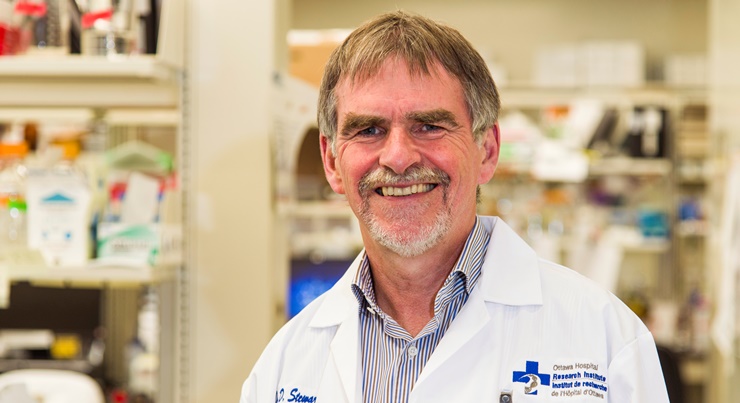
Dr. Duncan Stewart pioneered the world’s first clinical trial of a genetically enhanced stem cell therapy for pulmonary arterial hypertension.
Imagine feeling so tired that you can’t get out of bed for more than a few hours a day, and so short of breath that you can’t even walk around the block. That is what many people with pulmonary arterial hypertension (PAH) face every day.
This rare and deadly disease occurs when the arteries that supply blood to the lungs become so damaged that the blood can’t flow properly to take up oxygen. It can strike anyone at any age, although women are affected about twice as often as men. In some cases, PAH is caused by a defective gene, but in many cases, the cause is unknown.
Dr. Duncan Stewart, senior scientist at The Ottawa Hospital and professor of medicine at the University of Ottawa, recently published promising results of the first clinical trial in the world of a genetically enhanced stem cell therapy for PAH.

Sean Mullin, who has pulmonary arterial hypertension, welcomed the results of the stem cell therapy trial and hopes that more trials will improve the options for patients like him.
Sean Mullin, a Finch, Ontario man who was diagnosed with PAH in 2008, hopes there will be more trials in the future.
“I have developed many friends with this disease and too many have died over the last few years,” Mullin said. “I really hope that stem cell therapy will be a way out, or will at least give us a better option than lung transplantation.”
The idea for this therapy arose more than 15 years ago, when a drug called prostaglandin became available for PAH patients, said Dr. Stewart, who is also a cardiologist and executive-vice president of research at The Ottawa Hospital.
“This drug could modestly improve symptoms in some patients, but it required patients to be hooked up to a pump for the rest of their lives and they lived in fear of a kink in the tube, a mechanical failure or an infection,” he said.
“So we wondered if we could somehow engineer the body’s own cells so that they could produce this drug, or perhaps an even better drug, and get rid of the pump. In other words, we wanted to turn the body’s own cells into tiny drug factories.”
The idea was completely novel, and there were many hurdles to overcome, but eventually Dr. Stewart and his colleagues treated seven patients in the world’s first clinical trial of this kind of therapy.
“Although our study was designed only to look at the safety and feasibility of a single dose of this novel therapy, we did find that patients had improved blood flow in the lungs in the days following the therapy. They could also exercise better and had improved quality of life for up to six months,” said Dr. Stewart. “These results are preliminary, but we are very encouraged. We look forward to refining the therapy and doing more trials in the future.”
Please see the media release for more details.

Support patient care and research at
The Ottawa Hospital


 To reset, hold the Ctrl key, then press 0.
To reset, hold the Ctrl key, then press 0.